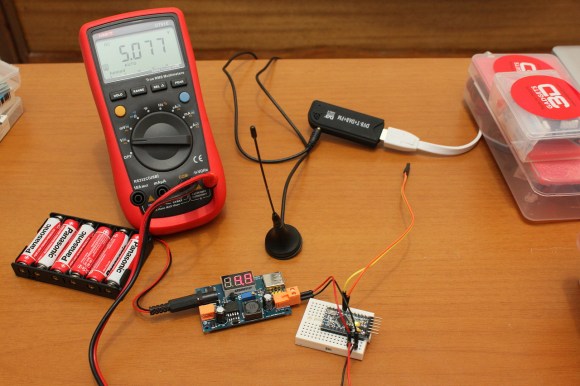Being curious by nature, [Marios] decided to see what kind of radio-frequency emissions may be generated by an Arduino connected to a simple breadboard wire, and more importantly try to pick them up using a RTLSDR dongle. Electromagnetic interferences are disturbances that affect electrical circuits due to either electromagnetic induction or electromagnetic radiation. Before going into the market, all electrical devices are thoroughly checked for unwanted electromagnetic emissions so they usually aren’t obvious suspects when such problems arise.
Using the Arduino embedded PWM controller in fast PWM mode and by manipulating the duty cycle, he actually managed to create a primitive form of amplitude modulation and was able to transfer a very simple audible signal at several frequencies up to 1.75GHz. Embedded after the break here is video of the system at work.
As a side note, did you know that during the solar storm of 1859 the EMI were so strong that the telegraph operators received several shocks? Pipelines maintenance systems also have to be aware of such events, that can lead sensors to provide inaccurate results.
[via Dangerous Prototypes]
















I experimented a bit with producing an AM radio signal using a microcontroller and a wire. http://amcinnes.info/2012/uc_am_xmit/
Did I hear somebody say dongle?
Raise them. Now.
On a more serious note, maybe this is a good thread to ask. I’m getting noise from my headphones on dell computers at my school. It concerns me b/c I can hear more than just PSU noise (just w/ my ears), and any movement of pixels on LCD screen. From what I’ve read it’s due to cheap/crap design and not properly grounding/shielding ports (of all ports, the audio may be most important…). I won’t be able to open the box and apply ferrite b/c it’s a school computer, does anyone else have this problem? I’m planning on using like Jack Audio software and trying to find exact frequency and connect what I’m hearing w/ what I’m doing on the PC to show my school security vulnerability so they fix it. [Sorry for long post/maybe slightly OT]
If you are “lucky” , electromagnetic interference is directly introduced into the headphone cable itself . Then just slip some ferrite beads from TDK, FairRite, WURTH , LAIRD over the headphone cable near the plug . jerry at JDM LABS
I’m usually never lucky when I want to be, but I want to get the source of the noise. The entire school uses dell computers, and most buildings are public so there could be a lot of “interesting noise” floating around for attackers. Thanks though, checked out your site at elitetest.com; too bad I’m a broke college student to afford consulting lol.
I think I know what you speak of. I had the same issue with an old computer. Whenever I moved the mouse of did anything I would here beeps and boops hidden in noise that would correspond with the visual movement on screen.
There is no vulnerability to fix or repair, it’s just shitty hardware. Get yourself a good pair of USB headphones and the problem should go away.
like some are assuming its all hardware related, the onboard sound cards are not the most noisy friendly designs. plops and other are picked from the powersuply and are poping out into your speakers, earbuds what ever your using. one thing you could do is getting an external good sound card but it’s not cheap. i don’t think they will replace all those dells in your school. if you want to learn some more about audio sound check some music producers forums.
You could try using a USB sound card. That will give you something that is portable between machines, is isolated from the internal electrical noise and is cheap (less than £5 from Amazon)
That computer might not even be plugged into a grounded outlet, and a third prong does not mean it’s always connected, so don’t be fooled.
Or/and have some cheap-ass plastic case.
when experimenting with transmitting an signal of any kind you have to look to rf filters to kill the harmonics take a look at bandpass filters or lf or hf filters
Why not go to the trouble and reading the article, before writing a complete and utterly wrong resume ? It’s not the SDR dongle that is used for the PWM, it’s an Arduino… Sigh!
Thanks for the correction Per… it’s actually the editor that made a mistake here ^^
It probably is the dongle being oversaturated that creates fake reflections on such high frequencies though.
Reminds me of the attiny85 fm transmitter that was featured on hackaday.
http://spritesmods.com/?art=avrfmtx&page=1
Welcome to Hardening 101. if your signal can get out, interference can get in. Plus if you dont do things right you can leak data. I have seen embedded code for challenge – respnse keyfobs that ad in random operations to obfuscate the signals that can be listened in on to make it very difficult to snoop on the signal.
While he is at it, it would be nice to measure what comes out of that DC DC converter…
I’ve used the same trick, but with a completely opposite goal in mind!
The little monopole that comes with the SDR is good for some things, but it’s also not difficult to make a basic near-field probe out of coaxial cable (pro tip: slice off the cheap antenna, and reuse the cable you already have!).
Yeah sure, the cable is top notch it’s just the antenna that is a 20 cents deal..
In fact you are probably wiser to replace the cable and have a usable antenna.
I just ordered on of those dongles. I’m going to use it to see if I can grab our baby monitor so I can have that on my computer. Hopefully it makes more sense once I start playing with it. I only grasp half of the article and I’m a complete novice.